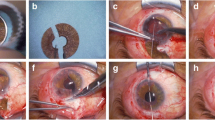Abstract
Purpose
To describe a novel surgical technique for iridodialysis repair using an iris retractor segment and report its clinical results.
Methods
Fifty-three eyes of 53 patients who underwent iridodialysis repair using an iris retractor segment were enrolled in this retrospective study. Data recorded from patient files consisted of age, sex, degree of iridodialysis, surgical techniques, number of segments used, preoperative and postoperative corrected distance visual acuity (CDVA), intraocular pressure (IOP), complications, and follow-up time.
Results
Mean follow-up time was 34.4 months. The subjects included 29 men (54.7%) and 26 women (45.3%), and the mean age was 56.6 ± 14.0 years. According to the degree of iridodialysis, the patients were divided into Group 1 (60°–89°, n = 19) and Group 2 (90°–270°, n = 34). During the iridodialysis repair for Group 1, a single segment was sufficient; however, in Group 2, one segment was used in 18 eyes (52.9%), two segments in 15 eyes (44.1%), and three segments in one eye (2.9%). The pre- and postoperative last control CDVA value in Group 2 was significantly lower than in Group 1. The pre- and postoperative IOPs for Group 2 were significantly higher than Group 1.
Conclusion
Iridodialysis repair using an iris retractor segment is a minimally invasive technique and found to be safe and effective. It will be a good option for patients with large iridodialysis, as it avoids excessive surgical manipulations and prolonged surgical time.


Similar content being viewed by others
Availability of data and material
The datasets used and analyzed during the current study are available from the corresponding author on reasonable request.
References
Kumar S, Miller D, Atebara N, Blance E (1990) A quantitative animal model of traumatic iridodialysis. Acta Ophthalmol (Copenh) 68(5):591–596. https://doi.org/10.1111/j.1755-3768.1990.tb04794.x
McCannel MA (1976) A retrievable suture idea for anterior uveal problems. Ophthalmic Surg 7(2):98–103
Nunziata BR (1993) Repair of iridodialysis using a 17-millimeter straight needle. Ophthalmic Surg 24(9):627–629
Wachler BB, Krueger RR (1996) Double-armed McCannell suture repair for repair of traumatic iridodialysis. Am J Ophthalmol 122(1):109–110. https://doi.org/10.1016/s0002-9394(14)71971-3
Bardak Y, Ozerturk Y, Durmus M, Mensiz E, Aytuluner E (2000) Closed chamber iridodialysis repair using a needle with a distal hole. J Cataract Refract Surg 26(2):173–176. https://doi.org/10.1016/s0886-3350(99)00365-x
Snyder ME, Lindsell LB (2011) Nonappositional repair of iridodialysis. J Cataract Refract Surg 37(4):625–628. https://doi.org/10.1016/j.jcrs.2011.02.001
Narang P, Agarwal A (2020) Trocar assisted non-appositional repair of iridodialysis. Eur J Ophthalmol:1120672120948747. https://doi.org/10.1177/1120672120948747
Agarwal T, Singh D, Panda A (2011) Guide needle-assisted iridodialysis repair. J Cataract Refract Surg 37(10):1918; author reply 1918–1919. https://doi.org/10.1016/j.jcrs.2011.08.009
Aron N, Sinha R, Sharma N, Agarwal T (2018) Isoexpansile sulfur hexafluoride gas to repair near-total iris disinsertion. J Cataract Refract Surg 44(10):1175–1178. https://doi.org/10.1016/j.jcrs.2018.06.024
Richard JC, Kennedy CJ (2006) Sutureless technique for repair of traumatic iridodialysis. Ophthalm Surg Lasers Imaging 37(6):508–510. https://doi.org/10.3928/15428877-20061101-14
Voykov B (2016) Knotless technique for iridodialysis repair. Clin Exp Ophthalmol 44(2):135–136. https://doi.org/10.1111/ceo.12586
Silva JL, Póvoa J, Lobo C, Murta J (2016) New technique for iridodialysis correction: single-knot sewing-machine suture. J Cataract Refract Surg 42(4):520–523. https://doi.org/10.1016/j.jcrs.2016.03.021
Kusaka M, Miyamoto N, Akimoto M (2019) Repairing iridodialysis by riveting with double-flanged polypropylene suture. J Cataract Refract Surg 45(11):1531–1534. https://doi.org/10.1016/j.jcrs.2019.08.001
Wan W, Shi L, Li C (2018) Comparing safety and efficiency of two closed-chamber techniques for iridodialysis repair - a retrospective clinical study. BMC Ophthalmol 18(1):311. https://doi.org/10.1186/s12886-018-0984-y
Baykara M (2004) Suture burial technique in scleral fixation. J Cataract Refract Surg 30(5):957–959. https://doi.org/10.1016/j.jcrs.2003.09.048
Siepser SB (1994) The closed-chamber slipping suture technique for iris repair. Ann Ophthalmol 26(3):71–72
Nova’k J (1997) Flexible iris hooks for phacoemulsification. J Cataract Refract Surg 23(6):828–831. https://doi.org/10.1016/s0886-3350(97)80238-6
Lee V, Bloom P (1999) Micro hook capsule stabilization for phacoemulsification in eyes with pseudoexfoliation-syndrome-induced lens instability. J Cataract Refract Surg 25(12):1567–1570. https://doi.org/10.1016/s0886-3350(99)00264-3
Tsai CH, Hsiao CH, Ku WC (2006) Flexible iris retractors for management of zonular dialysis during planned phacoemulsification. Chang Gung Med J 29(5):499–504
Acknowledgments
Muhammed Ilyas, Ph.D., provided assistance with statistics and English-language editing.
Funding
The authors obtained no commercial provider for the investigation, authorship, and broadcasting of the study.
Author information
Authors and Affiliations
Contributions
U.U. conceived the idea. U.U. and M.S. performed surgeries, and U.U. collected the data. H.S. analyzed the data, and H.S. wrote the manuscript. U.U., M.S., and H.S. revised the manuscript. All authors approved the final version.
Corresponding author
Ethics declarations
Conflict of interest
The authors declare they have no financial conflict of interest related to this article.
Ethics approval and consent to participate
All procedures performed in studies involving human participants were in accordance with the ethical standards of the Faculty of Medicine, Izzet Baysal University/Bolu. All procedures conformed to the tenets of the Declaration of Helsinki. Written informed consent was obtained from all individual participants included in the study.
Consent for participation and publication
The authors declare they have participated in this work, and they have reviewed the final version of the work, believe it represents valid work, and approve it for publication.
Additional information
Publisher's Note
Springer Nature remains neutral with regard to jurisdictional claims in published maps and institutional affiliations.
Supplementary Information
Below is the link to the electronic supplementary material.
Online Resource 1. A demonstrative video showing the iridodialysis repair using an iris retractor segment.
Online Resource 2. A demonstrative video showing the iridodialysis repair using multiple iris retractor segments
Rights and permissions
About this article
Cite this article
Unsal, U., Sabur, H. & Soyler, M. Results of a novel surgical technique for iridodialysis repair using an iris retractor segment. Int Ophthalmol 42, 219–227 (2022). https://doi.org/10.1007/s10792-021-02016-4
Received:
Accepted:
Published:
Issue Date:
DOI: https://doi.org/10.1007/s10792-021-02016-4




